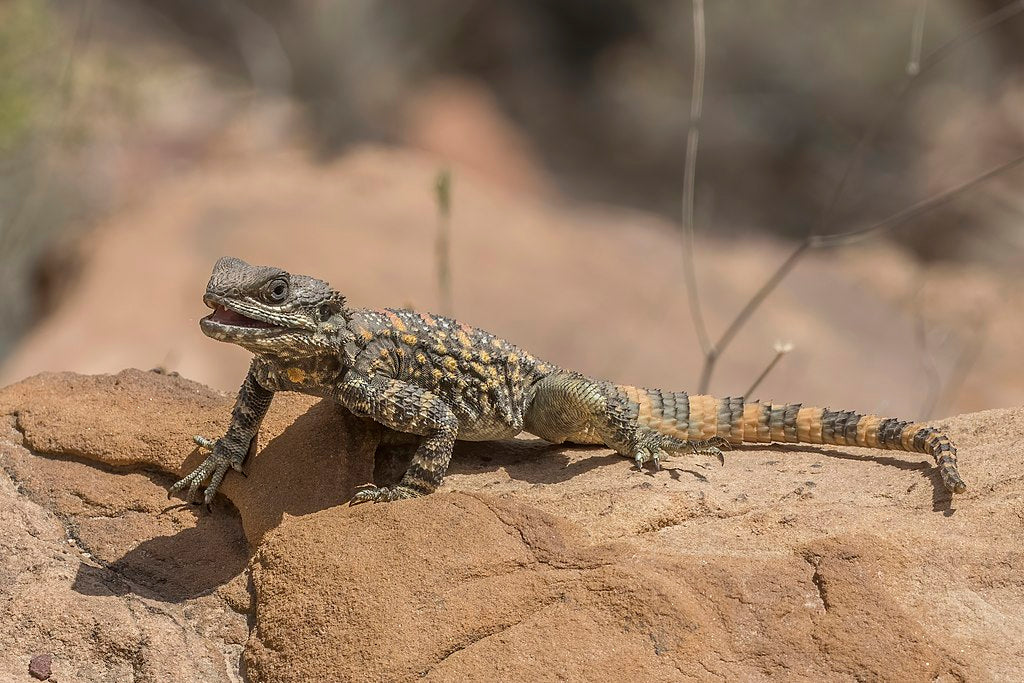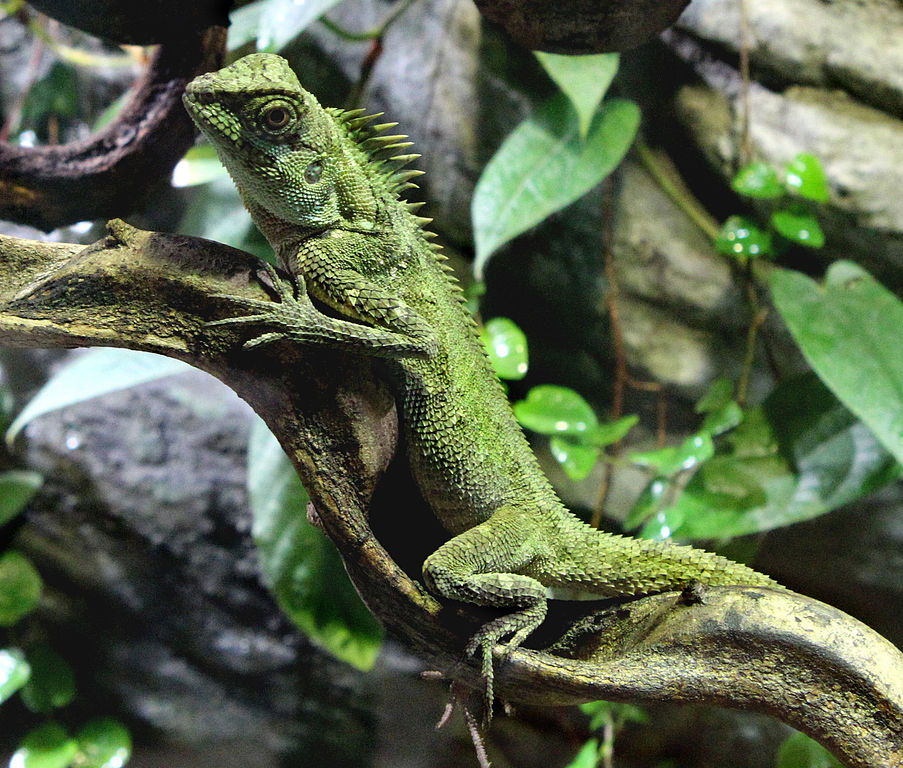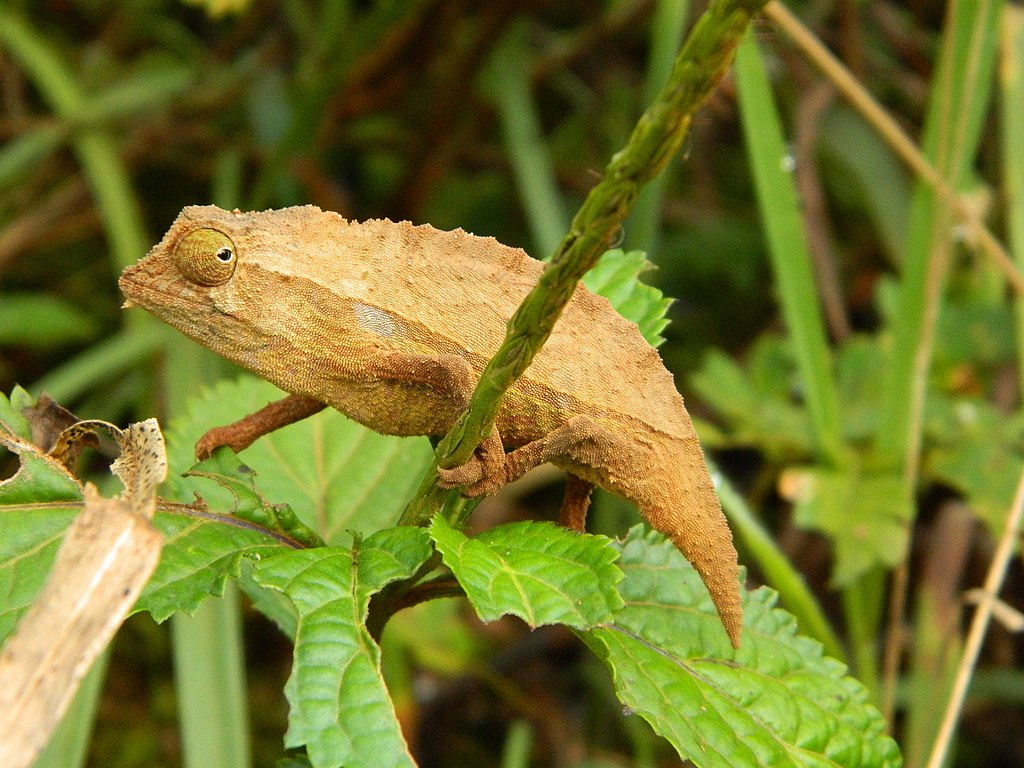Painted agamas (Stellagama stellio) are small- to medium-sized diurnal, terrestrial lizards that can be found along the northeastern and eastern Mediterranean. They prefer dry, rocky habitats, with sparse, dry vegetation. This lizard is known by many names, including painted agama, painted dragon, roughtail rock agama, clown agama, sling-tailed agama, starred agama, and hardun.
Adult painted agamas average 12-14” long, with a bearded dragon-like appearance: large triangular head, brow ridges, keeled scales, transverse ridges across the back, tubercles along the sides, and rings of keeled scales around the tail. Exact coloring varies by subspecies, but most painted agamas in captivity have a tan to gray base color with a mixture of gray, orange, and/or white spots of various sizes. The tail typically has a ringed pattern.
Painted agamas are relatively uncommon in the US pet trade, but they can make a good pet for someone who likes the idea of a bearded dragon but doesn’t quite have the space for one. This species typically acclimates to humans well and will tolerate hand-feeding as well as handling. This is an intermediate-difficulty pet reptile.
How much space do painted agamas need?
A single painted agama should be housed in no smaller than a 36” x 18” x 18” enclosure (~40 gallons). However, painted agamas are very active lizards, so if you can provide a larger enclosure, do it!
Cohabitation is optional. If you wish to keep multiple painted agamas in the same terrarium, do not house multiple males together, as they may fight and injure one another. Small groups of similarly-sized females seem to be the safest option. A male and female(s) should only be kept together if you wish to breed. For housing multiple painted agamas in one enclosure, you will need a 48” x 24” x 24” or larger.
Do painted agamas need UVB?
Yes! Painted agamas are diurnal, which means that they are most active during the day, and naturally exposed to lots of sunlight on a day-to-day basis. This means that they need UVB light as part of their enclosure. The best UVB bulbs for a painted agama housed in a 18-24” tall enclosure are:
- Zoo Med Reptisun T5 HO 10.0
- Arcadia Desert 12%
Your UVB bulb should be roughly half the length of the enclosure and mounted in a high-quality Arcadia ProT5 or Vivarium Electronics fixture for optimum function. The UVB lamp should be placed on the same side of the enclosure as the heat lamp(s), with the basking area being the closest surface to the UVB fixture.
- Note that UVB is blocked by glass and plastic, so you can’t give your lizard UVB by placing its terrarium in front of an open window. Also make sure that the fixture your UVB bulb is in does not have a clear plastic bulb cover!
In addition to UVB, since painted agamas are day-active lizards, it’s beneficial to provide an additional daylight-spectrum lamp to make sure the enclosure is brightly illuminated. Use a strong 6500K LED or T5 HO fluorescent plant grow light for best results.
Painted agamas should get 10 hours of light per day during winter and 14 hours of light per day during summer. This simulates natural seasonal changes in day length and encourages healthier hormonal rhythms.
What basking temperatures do painted agamas need?
Painted agamas like it hot! They should have a basking surface temperature between 105-115°F, with cool side temperatures between 70-85°F. The heat source should be turned off at night to let the enclosure cool off, which can go as low as 62°F. Measure your temperatures with a digital probe thermometer with the probe placed on the desired surface.
Provide heat for your painted agama by imitating the sun with a low-wattage halogen flood heat lamp placed on one side of the enclosure. Do not use ceramic heat emitters (CHEs), heat mats, red bulbs, or blue bulbs, as these are not as effective. For best results, the basking surface itself should be a large, flat piece of rock.
What humidity levels do painted agamas need?
Painted agamas are native to a semi-arid environment and don’t need much in the way of humidity. However, it’s best to provide low humidity (15-35%) during the day and high humidity (90-100%) at night to replicate their Mediterranean native habitat. Use a digital probe hygrometer with the probe in the middle of the terrarium to measure and keep track of humidity levels.
To increase humidity at night you can either mist the enclosure with a pressure sprayer each evening, or you can set a timer to turn on a fogger each night for a few hours. A quick, light misting first thing in the morning can also be beneficial because it creates “dew” for your agama to drink. As long as the enclosure is well-ventilated, the mistings should not create problems for your pet.
What substrate is good for painted agamas?
Substrate covers the floor of your lizard’s terrarium and helps make the enclosure more attractive, but it also helps maintain desired humidity levels and provides something for your pet to dig around in.
It’s ideal to use a substrate that imitates the “substrate” that the reptile naturally lives on in the wild. For painted agamas, that means sand or sandy soil. We recommend the following substrates for painted agamas:
- Zoo Med ReptiSand
- Exo Terra Desert Sand
- 60/40 play sand/topsoil mix
Substrate should be at least 2” deep and completely replaced every 3-4 months. Remove poop and urates daily, along with contaminated substrate.
What décor can you use in a painted agama terrarium?
A bored lizard is a stressed lizard, so it’s important to provide sources of enrichment to help keep your pet entertained and engaged with its environment. It doesn’t matter how big the enclosure is if you don’t put things in it for your pet to use and interact with!
At bare minimum, you will need at least two places for your agama to hide in and a flat stone for basking on. However, this still results in a pitifully bare enclosure. Here are other suitable items to fill up the space and increase the enclosure’s functionality:
- secure stacks of flagstone or aquarium slate
- ledges
- hollow logs
- branches
- drought-tolerant live or artificial plants
For inspiration on how to set up your enclosure, it helps to browse through pictures of painted agamas in their natural habitat!
What do painted agamas eat?
Painted agamas are omnivorous, which means that they need a balanced diet of both animal prey (insects) and vegetation in order to get the nutrition that their bodies need. Here’s a basic feeding schedule:
- Juveniles — salad daily, insects daily
- Adults — salad daily, insects every other day
Offer as many bugs as your pet will eat from tongs or a bowl in about 5 minutes. Variety is the key to balanced nutrition, so make sure to offer as many different kinds of foods as possible!
Feeder insects for painted agamas: dubias, discoids, red runner roaches, crickets, black soldier fly larvae, hornworms, silkworms, mealworms
Leafy greens for painted agamas: alfalfa, arugula/rocket, bok choy, brussels sprouts, cactus pads, carrot greens, cress, collard greens, dandelion greens, endive, kale, mustard greens, radicchio, red leaf lettuce, romaine lettuce, spinach, turnip greens
Don’t be too alarmed if your agama doesn’t finish its salads. The salads are there to provide a selection of greens for your pet to snack on to round out its diet. As long as it’s eating some greens, it’s probably fine. However, if you notice your pet getting a bit chubby, that’s a sign that you need to cut back on the insects.
Supplements
You will need calcium and vitamin supplements to prevent your agama from developing a nutrient deficiency. We recommend Repashy Calcium Plus LoD, lightly dusted on all feeder insects. Do not dust salads.
Water
Although painted agamas are native to a fairly dry environment, they still need access to fresh water. Provide a small water bowl where your lizard can always get a drink as needed. Change the water daily and scrub the bowl with a reptile-safe disinfectant weekly (or whenever it becomes soiled).
Do painted agamas like to be handled?
Like the bearded dragons that they are frequently compared to, painted agamas are known to tame down and learn to tolerate regular human interaction well. They can be hand-fed as well as handled and petted once they have learned to trust you!
It takes consistent positive interactions to build a trust relationship with a reptile. It’s best to encourage your agama to come out of the enclosure and climb onto you on its own, rather than forcibly grabbing it. Hand-feeding is great for incentivizing this behavior — if you’re worried about getting accidentally nipped during hand-feeding, use a pair of soft-tipped feeding tweezers.
When picking up your agama, slowly scoop from below, and when you’re actually holding your pet, support as much of its body as possible, especially its feet. This will help it feel like it’s not about to fall. Initial handling sessions should happen inside the enclosure to help the lizard feel more comfortable.
*This care sheet contains only very basic information. Although it’s a good introduction, please do further research with high-quality sources to obtain additional information on caring for this species.
"File:Roughtail rock agama (Stellagama stellio brachydactyla).jpg" by Charles J Sharp is licensed under CC BY-SA 4.0.




Leave a comment
This site is protected by hCaptcha and the hCaptcha Privacy Policy and Terms of Service apply.